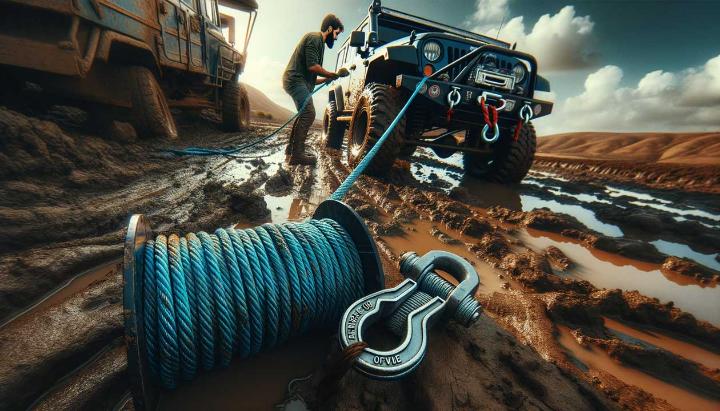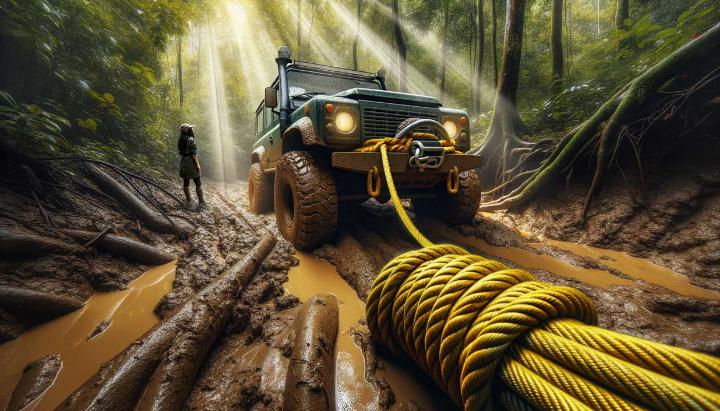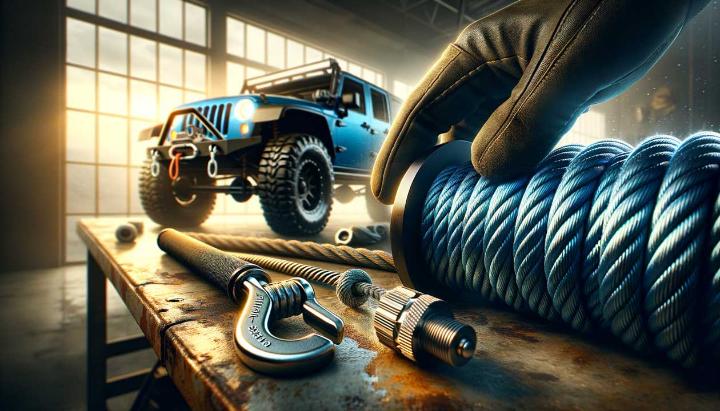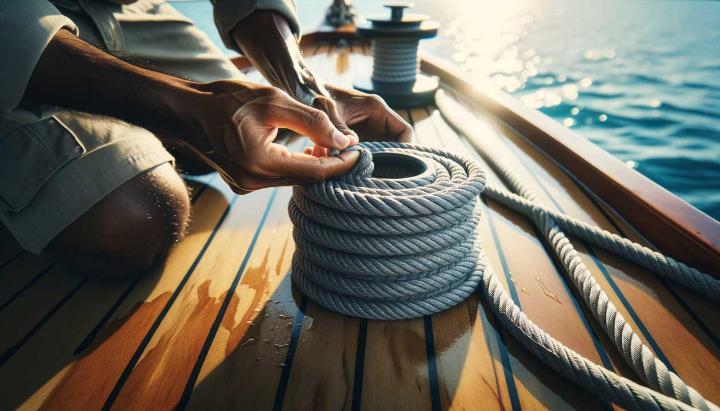Have you ever found yourself in a sticky situation, miles from civilisation, with only your winch standing between you and a long, cold night in the bush? If so, you know that the difference between a quick recovery and a nightmare scenario often comes down to one crucial component: your winch line.
Welcome to the ultimate guide on choosing the best winch line for your off-road adventures. Whether you're a seasoned 4x4 enthusiast or just getting started with your first in line winch, this comprehensive guide will help you navigate the complex world of winch lines, from high-tech synthetic ropes to traditional 2 in manila rope.
Did you know that the right winch line can make the difference between a 3-tonne and an 11.3-tonne breaking strength? Or that some advanced synthetic ropes offer a mere 3% stretch rate, ensuring a stable and controlled recovery? We'll dive deep into these game-changing features and more, equipping you with the knowledge to make an informed decision that could save your skin when the going gets tough.
In this guide, we'll explore the key factors to consider when selecting a winch line, compare different materials and their unique properties, and provide expert tips on matching your winch line to your specific needs. So buckle up, mate - you're about to become a winch line connoisseur!
Understanding Different Types of Winch Lines
When it comes to choosing the best winch line for your needs, it's crucial to understand the different types available. As an avid off-roader and recovery enthusiast, I've had my fair share of experiences with various winch lines. Let's dive into the world of winch lines and explore the options that could make or break your next recovery operation.
Synthetic vs Steel Winch Lines
The two main contenders in the winch line arena are synthetic ropes and steel cables. Each has its own set of strengths and weaknesses, and choosing between them often comes down to your specific needs and preferences.

Synthetic Winch Lines
Synthetic winch lines, typically made from materials like Dyneema or Spectra, have gained immense popularity in recent years. I remember the first time I used a synthetic line on a muddy trail in the outback - it was a game-changer!
- Lightweight and easy to handle: Synthetic lines are a breeze to work with, especially when you're knee-deep in mud.
- High strength-to-weight ratio: Don't let their light weight fool you; these ropes can pack a serious punch when it comes to breaking strength.
- Safety advantages: If a synthetic line breaks, it doesn't store energy like steel, reducing the risk of dangerous whiplash.
- Floats on water: A handy feature for water crossings or marine applications.
Steel Winch Cables
Steel cables have been the traditional choice for winch lines, and they still have their place in the off-road world. I've relied on steel cables in some of the harshest conditions imaginable.
- Excellent abrasion resistance: Steel cables can withstand rough terrain and sharp edges better than their synthetic counterparts.
- Heat resistant: Ideal for prolonged, heavy-duty winching operations where heat build-up can be an issue.
- Lower cost: Generally more budget-friendly than synthetic options.
- Longevity: With proper care, a steel cable can last for years, even in tough conditions.
Choosing the Right Winch Line for Your Needs
Selecting the perfect winch line isn't just about personal preference; it's about matching the line to your specific application. Consider factors like:
- Breaking strength: Ensure the line can handle your vehicle's weight and potential recovery situations.
- Diameter: Match the line diameter to your winch's specifications for optimal performance.
- Flexibility: Think about how often you'll be spooling and unspooling the line.
- Environmental conditions: Will you be dealing with mud, rocks, or water crossings regularly?
Remember, the best winch line is the one that meets your unique needs and gives you confidence in your recovery gear. Whether you're tackling tough trails or preparing for emergency situations, choosing the right winch line can make all the difference.
Pro tip: Always inspect your winch line before each use, regardless of the material. A well-maintained line is a safe line!
Key Features of the Best Winch Line
When it comes to choosing the best winch line for your off-road adventures or recovery operations, understanding the key features is crucial. As someone who's been stuck in more muddy ruts than I care to admit, I've learned that the right winch line can make all the difference between a quick recovery and a long, frustrating day in the bush.
Breaking Strength and Load Capacity
The breaking strength of your winch line is arguably the most critical factor to consider. It's not just about how much weight your vehicle tips the scales at - you need to account for the additional forces at play during a recovery.
- Rule of thumb: Choose a winch line with a breaking strength at least 1.5 times your vehicle's gross weight.
- Safety margin: This extra capacity accounts for dynamic loads and unexpected obstacles during winching.
- Real-world application: For my 2.5-tonne 4x4, I opt for a winch line with at least a 3.75-tonne breaking strength.
Durability and Abrasion Resistance
Your winch line needs to withstand the harsh realities of off-road use. Whether you're dragging it over rocky terrain or wrapping it around a tree, durability is key.

Synthetic ropes, like those made from Dyneema, often feature special coatings to enhance abrasion resistance. For instance, some manufacturers use a proprietary blend that can increase abrasion resistance by up to 15%. This means fewer frays and a longer lifespan for your winch line.
Stretch and Elasticity
The stretch factor of your winch line plays a crucial role in both performance and safety. Here's why it matters:
- Energy absorption: A slight stretch can help absorb shock loads, reducing stress on your winch and vehicle.
- Controlled recovery: Too much stretch can lead to unpredictable movement during winching.
- Optimal performance: Look for winch lines with a stretch rate of around 3% or less for the best balance.
I once used a line with too much stretch, and let me tell you, it felt like trying to reel in a fish with a bungee cord. Not ideal when you're trying to get unstuck from a bog!
UV Resistance and Chemical Resistance
Your winch line isn't just battling terrain; it's also up against the elements. UV rays can degrade synthetic materials over time, while exposure to various chemicals can weaken the line.
Pro tip: Look for winch lines specifically treated for UV and chemical resistance. This is especially important if you frequently use your winch in sunny conditions or around marine environments.
Remember, the best winch line for you depends on your specific needs and the conditions you'll be facing. By considering these key features, you'll be well-equipped to choose a winch line that won't let you down when the going gets tough. Have you had any experiences where the right (or wrong) winch line made all the difference? Share your stories in the comments below!
Matching Your Winch Line to Your Specific Application
When it comes to choosing the best winch line, one size definitely doesn't fit all. As someone who's been in countless recovery situations, I can tell you that matching your winch line to your specific needs is crucial for both performance and safety. Let's dive into the nitty-gritty of selecting the perfect winch line for your unique requirements.
Choosing the Right Winch Line Size and Material
The first step in selecting your ideal winch line is determining the right size and material. This decision can make or break your recovery operation, so it's essential to get it right.
- Winch line diameter: Generally, the larger the diameter, the stronger the line. For most 4x4 applications, a 3/8" to 1/2" diameter is suitable.
- Material selection: Synthetic rope and steel cable each have their pros and cons. Synthetic is lighter and safer to handle, while steel offers better abrasion resistance.

Here's a quick reference chart to help you choose the right winch line diameter based on your vehicle weight:
| Vehicle Weight | Recommended Winch Line Diameter |
|---|---|
| Up to 3,500 lbs | 3/16" - 1/4" |
| 3,500 - 6,000 lbs | 5/16" - 3/8" |
| 6,000 - 10,000 lbs | 3/8" - 7/16" |
| Over 10,000 lbs | 1/2" or larger |
Understanding Winch Line Strength Requirements
Knowing your winch line's strength requirements is crucial for safe and effective recovery operations. Here's what you need to consider:
- Working load limit (WLL): This is the maximum weight your winch line can safely handle during normal operations.
- Breaking strength: The point at which your winch line will fail under tension. Always choose a line with a breaking strength higher than your needs.
- Safety factor: Aim for a safety factor of 1.5:1 to 2:1. This means your winch line's breaking strength should be 1.5 to 2 times your vehicle's gross weight.
To calculate your required winch line strength, use this formula:
Required Breaking Strength = Vehicle Weight x 1.5
For example, a 5,000 lb vehicle would need a winch line with at least 7,500 lb breaking strength.
Remember, these are minimum requirements. It's always better to err on the side of caution and choose a stronger line if you're unsure.
Synthetic vs. Steel Winch Lines: Pros and Cons
Both synthetic and steel winch lines have their place in the recovery world. Let's break down their strengths and weaknesses to help you make an informed decision:
- Synthetic winch rope: Lightweight, easy to handle, and safer if it breaks. Ideal for frequent use and situations where weight is a concern.
- Steel winch cable: More durable, heat-resistant, and generally less expensive. Better for heavy-duty industrial applications or where abrasion is a major concern.
In my experience, synthetic winch lines have been a game-changer for off-road recovery. They're much easier on the hands and don't store energy like steel cables, making them safer in the event of a break. However, for those working in particularly abrasive environments or dealing with extreme heat, steel cables might still be the way to go.
Pro tip: If you opt for a synthetic winch line, look for one with UV resistance and a protective coating to enhance durability. Some high-quality lines, like the one mentioned with a 11.3-tonne breaking strength and 15% increased abrasion resistance, can offer the best of both worlds.
Ultimately, the best winch line for you depends on your specific needs, the environments you'll be working in, and your personal preferences. By carefully considering the factors we've discussed, you'll be well-equipped to choose a winch line that won't let you down when the going gets tough. Remember, proper maintenance is key to prolonging the life of your winch line, regardless of the material you choose.
Have you had any experiences where choosing the right (or wrong) winch line made a significant difference in a recovery situation? Share your stories in the comments below – your insights could help fellow off-roaders make better decisions!
Essential Maintenance for Prolonged Winch Line Life
As an off-road enthusiast who's seen my fair share of winch line wear and tear, I can't stress enough how crucial proper maintenance is for keeping your winch line in top shape. Whether you're rocking a synthetic rope or sticking with the classic steel cable, regular care is the key to ensuring your winch line is ready for action when you need it most.
Regular Cleaning and Inspection of Winch Rope
Let me tell you, there's nothing worse than reaching for your winch line in a sticky situation, only to find it caked in mud and grit. That's why I make it a habit to clean and inspect my winch line after every outing. Here's my tried-and-true process:
- Unwind and rinse: Start by fully extending your winch line and giving it a good rinse with fresh water. This helps remove abrasive particles that can wear down your line over time.
- Gentle scrub: For stubborn dirt, use a soft brush and mild soap. Be gentle - you're cleaning, not scrubbing the life out of it!
- Thorough inspection: As you clean, keep an eye out for any frays, kinks, or wear spots. These are red flags that your line might be nearing the end of its life.
- Dry completely: Before rewinding, ensure your line is completely dry to prevent mould and mildew growth.

Remember, synthetic ropes and steel cables have different needs. Synthetic ropes are more susceptible to UV damage, so I always store mine out of direct sunlight when not in use. On the flip side, steel cables need regular lubrication to prevent rust and maintain flexibility.
Proper Lubrication and Storage Techniques
Now, let's talk about keeping your winch line happy when it's not pulling you out of a bog. Proper storage is half the battle in extending your winch line's lifespan.
- Steel cable care: If you're using a steel cable, apply a light coat of lubricant after cleaning. I prefer silicone-based lubricants as they repel water and don't attract dirt.
- Synthetic rope storage: For synthetic ropes, avoid storing them wet or dirty. I like to loosely coil mine in a breathable bag to protect it from UV rays and moisture.
- Tension matters: When rewinding your winch line, maintain slight tension. This prevents loose spots that can lead to kinks and tangles.
Pro tip: Never store your synthetic winch line under tension for long periods. This can lead to stretching and reduce its overall strength.
Speaking of strength, I recently came across a synthetic winch rope that boasts some impressive specs. With a 10mm diameter and a breaking strength of 11.3 tonnes, it's a beast! Plus, it has a mere 3% stretch rate, meaning it won't feel like you're pulling on a rubber band during recovery. The cherry on top? A special coating that increases abrasion resistance by 15%. Now that's a rope that's built to last! For more details, you can read about it here.
Remember, folks, your winch line is your lifeline out there in the bush. Treat it right, and it'll return the favour when you're in a pinch
Choosing the best winch line is vital for both performance and safety. This guide delves into understanding winch lines, comparing your options like synthetic ropes, steel cables, and unique choices such as 2 in manila rope. Evaluating crucial features—from breaking strength and load capacity to durability and UV resistance—is essential to match your winch line with specific applications, whether for off-road recovery, industrial use, or marine environments. Don't overlook maintenance, such as regular inspection and proper storage, to prolong the life of your winch line. For top-notch performance, consider our 10mm synthetic winch rope with a breaking strength of 11.3 tonnes, a 3% stretch rate, and enhanced abrasion resistance by 15%, making it perfect for various strenuous conditions. Invest in quality for confidence in every recovery situation.
Contact Us for the Best Winch Line Solutions
Ready to find the perfect winch line for your needs? Fill in the form above, and our experts will assist you in making the best choice for your specific applications. Your safety and performance are our top priorities.